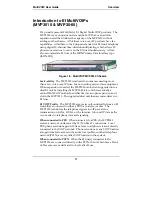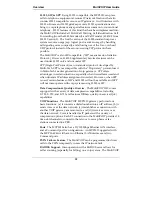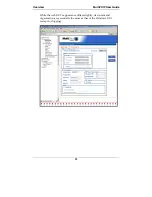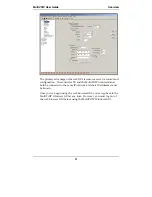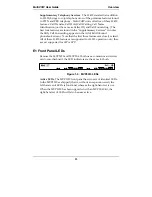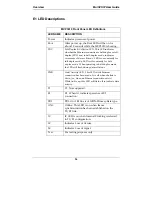
MultiVOIP User Guide
Overview
9
Introduction to TI MultiVOIPs (MVP2410 &
MVP24-48)
We proudly present MultiTech’s T1 Digital Multi-VOIP products.
The MVP2410 is a rack-mount model; and the MVP24-48 is an add-on
expansion card that doubles the capacity of the MVP2410 without
adding another chassis. These voice-over-IP products have fax
capabilities. These models adhere to the North American standard of
T1 trunk telephony using digital 24-channel time-division multiplexing,
which allows 24 phone conversations to occur on the T1 line
simultaneously. They can also accommodate T1 lines of the ISDN
Primary Rate Interface type (ISDN-PRI).
Figure 1-1. MultiVOIP MVP2410 LEDs
Scale-ability
. The MVP2410 is tailored to companies needing more
than a few voice-over-IP lines, but not needing carrier-class equipment.
When expansion is needed, the MVP2410 can be field-upgraded into a
dual T1 unit by installing the MVP24-48 kit, which is essentially a
second MultiVOIP motherboard that fits in an open expansion-card slot
in the MVP2410. The upgraded dual unit then accommodates two T1
lines.
T1 VOIP Traffic
. The MVP2410 accepts its outbound traffic from a T1
trunk that’s connected to either a PBX or to a telco/carrier. The
MVP2410 transforms the telephony signals into IP packets for
transmission on LANs, WANs, or the Internet. Inbound IP data traffic
is converted to telephony data and signaling.
When connected to PBX
. When connected to a PBX, the MVP2410
creates a network node served by 10/100-Base T connections. Local
PBX phone extensions gain toll-free access to all phone stations directly
connected to the VOIP network. Phone extensions at any VOIP location
also gain toll-free access to the entire local public-switched telephone
network (PSTN) at every other VOIP location in the system.
When connected to PSTN
. When the T1 line(s) connected to the
MVP2410 are connected directly to the PSTN, the unit becomes a Point-
of-Presence server dedicated to local calls off-net.
Summary of Contents for MULTIVOIP MVP-3010
Page 6: ...6 Chapter 1 Overview ...
Page 28: ...28 Chapter 2 Quick Start Instructions ...
Page 38: ...Technical Configuration T1 E1 MultiVOIP User Guide 38 Chapter 4 Software Installation ...
Page 49: ...49 Chapter 5 Technical Configuration ...
Page 58: ...Technical Configuration MultiVOIP User Guide 58 Config Info CheckList ...
Page 117: ...MultiVOIP User Guide Technical Configuration 117 ...
Page 139: ...MultiVOIP User Guide Technical Configuration 139 ...
Page 170: ...170 Chapter 6 T1 Phonebook Configuration North American Telephony Standards ...
Page 184: ...T1 Phonebook Configuration MultiVOIP User Guide 184 3 Select Inbound PhoneBook List Entries ...
Page 208: ...208 Chapter 7 E1 Phonebook Configuration European Telephony Standards ...
Page 252: ...252 Chapter 8 Operation and Maintenance ...
Page 257: ...MultiVOIP User Guide Operation Maintenance 257 The Call Progress Details Screen ...
Page 265: ...MultiVOIP User Guide Operation Maintenance 265 The Logs Screen ...
Page 277: ...MultiVOIP User Guide Operation Maintenance 277 ...
Page 280: ...Operation and Maintenance MultiVOIP User Guide 280 T1 Statistics Screen ...
Page 288: ...Operation and Maintenance MultiVOIP User Guide 288 ...
Page 343: ...343 Chapter 9 Warranty Service and Tech Support ...
Page 347: ...347 Chapter 10 Regulatory Information ...
Page 352: ...352 Appendix A Cable Pinouts ...
Page 358: ...358 Appendix B TCP UDP Port Assignments ...
Page 360: ...360 Appendix C Installation Instructions for MVP428 Upgrade Card ...
Page 365: ...MultiVOIP User Guide Index 365 Index ...
Page 395: ...395 S000384A ...

















